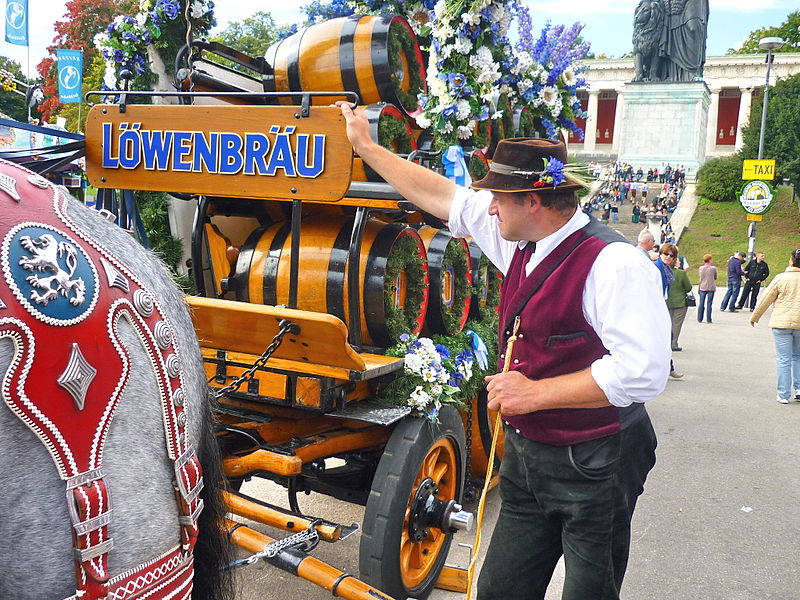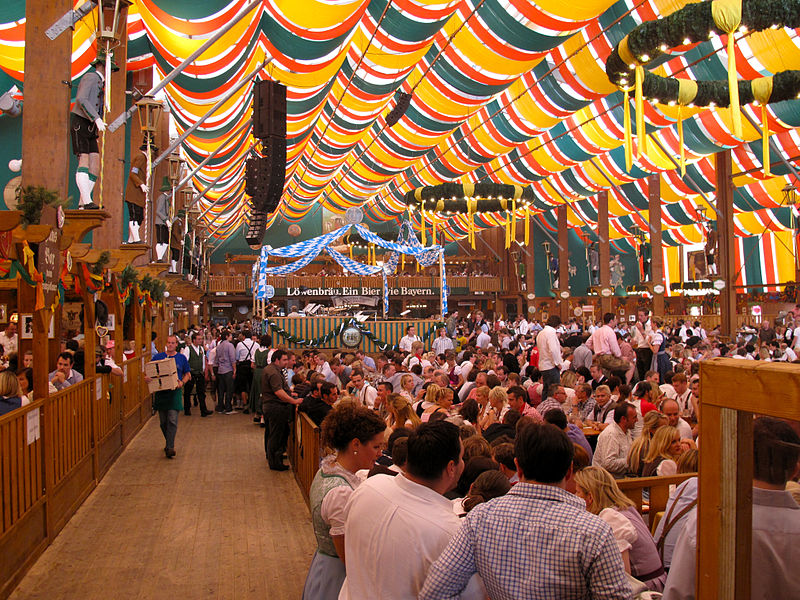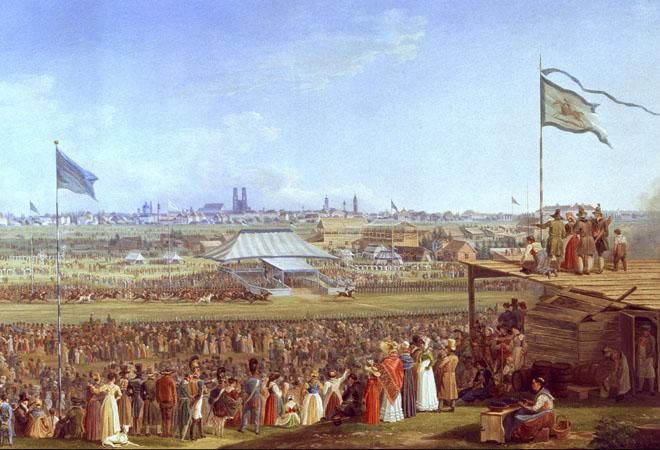Oktoberfest Isn't Really A Thing
At least outside of Bavaria.

Photo: Bayreuth2009/Wikimedia Commons
Germans head to the polls in TWO DAYS, you guys, which means the Fatherland’s quadrennial “vote fight” is finally, mercifully drawing to a close. However, what everyone is talking about right now isn’t the near-certainty of a fourth term under the world’s best tunic-haver, but instead the probable ascendance of the far-right Alternative for Germany party, whose Islamophobic piglet posters scared little kids (and me).
Anyway, this also means that like many Germans, I’m too freaked out to function properly, and since one can only stress-eat Tim Horton’s breakfast sandwiches for so much of the day, it’s a good time to remember that there is something else Germans are doing to occupy themselves for the final weeks of September: OKTOBERFEST!!! I mean, everybody loves Oktoberfest! Right now, every German everywhere is packed into Lederhosen and Dirndls, hoisting around one-liter Steins of extra-strong brewski and rocking out to Schlager until the wee hours!

Munich Oktoberfest, 2009. Photo: public domain
Except, they’re not.
I hate to break it to every German-American Club in our own Republic, most of whose members are at present deep in the throes of Knockwurst catatonia, but outside of Bavaria, Oktoberfest—originally a public feast honoring the marriage of the Crown Prince Ludwig to Therese of Saxe-Hildburghausen in 1810—isn’t a thing.

Oktoberfest 1823. Image: public domain
Remember, friends, until pretty damn recently, “Germany” as we know it was a tangled network of Electorates and rando city-states (that’s the technical term). Even today, every region has its own dialect, its own wackadoodle seasonal festivals, and its own culture, by which, as Dave Barry would say, I mean “beer.”
In the United States, however—a country, lest I remind you, that is about 50 times the size of Germany and has its own share of regional cultural differences—German always seems synonymous with Bavarian. Germany is giant steins of Bier. Germany is pretzels. Germany is Tracht, or traditional dress which, thanks to the Führer’s fondness for all things “traditional,” always carries the tinge of Nazism wherever it’s to be found (either unintentionally or intentionally, if you’re the AfD).
To most Germans, the American Vorbild (FORE-bild, archetype but literally “before-picture”) of Bavaria qua Germany ranges from perplexing to offensive; to me, because I have only lived in Berlin (and briefly Münster, on the direct other side of the country from Bavaria), my immediate associations with Germany aren’t Bavarian at all: they’re the Alexanderplatz TV tower, the New National Gallery, the Dussmann bookstore and every random street in Kreuzberg. And yet, when my publisher showed me the first mockups of the cover art for the book I wrote about Germany, these included: a ginormous greasy sausage (Oktoberfest!); the butt of a guy in Lederhose (OKTOBERFEST! GET IT?); and, finally, a classic Bavarian cuckoo clock that had been broken into splinters. Everybody else loved the cuckoo clock, but I am so disconnected from Bavarian culture that I was like, Wait, what the fuck is that thing? I had to Google “cuckoo clock Germany.”
Of course, I am aware that the regional truth of actual Oktoberfest will never dampen the gusto with which German-Americans (broadly conceived) celebrate it, or their alleged cultural heritage, or Herkunft (HAIR-koonft), writ large. In fact, there are entire “German” traditions celebrated Stateside that aren’t German at all. Take, for example, the mythical Weihnachtsgurke, or “Christmas pickle,” a tradition where parents hide a pickle ornament on the Christmas tree for kids to find. Germans do not do this. Germans have never done this. Germans love Christmas, and they love pickles, but never the twain shall meet. (Indeed, a true authentic German Tannenbaum contains only one thing: FIRE.)
And then there’s my personal favorite, “Schnitzelbank” (SHNIT-sul-BONK).
A few weeks ago, I was celebrating my daughter’s first day of preschool by giving her a paper cone full of enough candy to diabeticize her entire class (in the German tradition), and I got into the best Awl-related Twitter conversation that has ever come to pass. The sibling-writers Eve and Jesse Andrews were reminiscing about their Ausbildung at a German school in Pittsburgh, and while they had only hazy recollections of what may or may not have been a Schultüte (i.e. candy cone), both had vivid memories of something called “Schnitzelbank.”
it’s a combo children’s song & drinking song that teaches you opposites (here/there, crooked/straight). also it’s about furniture
— jesse andrews (@_jesse_andrews_) August 31, 2017
it's a combo children's song & drinking song that teaches you opposites (here/there, crooked/straight). also it's about furniture
— jesse andrews (@_jesse_andrews_) August 31, 2017
the chorus goes "oh you beautiful wood cutting bench"
— eve andrews (@eefandrews) August 31, 2017
our entire public elementary school class would sing it at annual recitals which in retrospect was kinda weird
— eve andrews (@eefandrews) August 31, 2017
I’d never heard of this before. I was like, What the fuck is that? Is this like the cuckoo clock? Am I truly the worst Germanist in the world? I may just be (I can’t tell the difference between Goethe and Schiller’s skulls, for one), but it turns out that I did have my own memory of “Schnitzelbank,” namely, thus:
So off I went, down the inevitable Schnitzelbank rabbit hole (as you do), and what I discovered was…YouTube after YouTube of middle-aged American guys in Lederhosen (LAY-dur-hoe-sun, and that’s the plural, as in “pantses”; here I am talking about multiple guys in multiple pairs; the singular is Lederhose, and that’s what one person wears). And here these guys are, schooling us all on the “correct” pronunciation of the word schön. (To be fair, the ö is pretty hard to approximate in English phonetics, but I’d go with SCHOOOOOOOEN before SHANE, pace Wayne Newton).
I mean, every line begins with the phrase Ist das nicht ein (ISST doss NISHT ayn), which technically means “is this not a,” but uses a construction, nicht ein (or “not a”) that is not correct in Standard German; German has its own word for that, kein (rhymes with “brine”), and as such every first-year German classroom in the world contains at least one poster with a circle-slash nicht ein on it. (I mean, maybe that shit flies in Bavarian, I don’t know.) Also, the word Schnitzelbank is feminine, so any article preceding it would be inflected with a feminine -e ending, so technically it would be Ist das keine Schnitzelbank, etc etc etc etc ekshully zat’s not right to the billionth. Something wasn’t richtig.
So I fact-checked, by which I mean I asked my friend Kersten, who serves as this column’s official cultural arbiter, subject-inspirer and spell-check. He said he’d never heard of “Schnitzelbank” until he attended one of Missouri’s innumerable German-American festivals (at which he, of course, felt profoundly out of place). Indeed, the song is thought to originate in early 20th-Century North America, for the purposes of passing on the (incorrect) language of the forbears to one’s Kinder.
Luckily, German’s don’t seem at all mad about this American “German” stuff—I mean, if they’re going to start something, I humbly re-submit this Heinz ketchup ad set in “an American diner” from 1993:
But it’s still worth remembering, for oh, I don’t know, no reason whatsoever, that when it comes to “authentic” German culture in America—whether that be the cleavage of Oktoberfest or something else entirely—more often than not, das ist nicht ein authentic representation. Prost!
